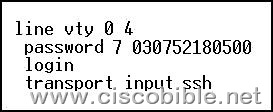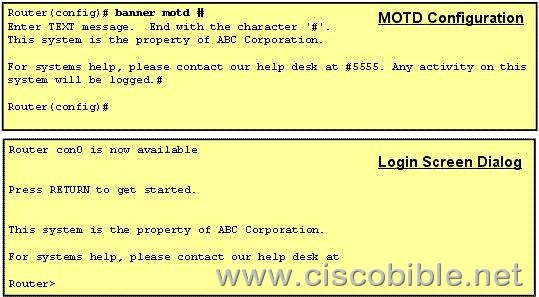1. In order to allow the establishment of a Telnet session with a router, which set of commands must be configured?
A: router(config)# line console 0
router(config-line)# enable password cisco
B: router(config)# line console 0
router(config-line)# enable secret cisco
router(config-line)# login
C: router(config)# line console 0
router(config-line)# password cisco
router(config-line)# login
D: router(config)# line vty 0
router(config-line)# enable password cisco
E: router(config)# line vty 0
router(config-line)# enable secret cisco
router(config-line)# login
F: router(config)# line vty 0
router(config-line)# password cisco
router(config-line)# login
Correct Answers: F
Explanation:
CLI Password Configuration:
|
Access From |
Password Type |
Configuration |
|
Console |
Console password |
Line console 0 Login Password cisco |
|
Auxiliary |
Auxiliary password |
Line aux 0 Login Password cisco |
|
Telnet |
Vty password |
Line vty 0 4 Login Password cisco |
2. Refer to the exhibit. What is the effect of the configuration that is shown?
A: It configures SSH globally for all logins.
B: It tells the router or switch to try to establish an SSh connection first and if that fails to use Telnet.
C: It configures the virtual terminal lines with the password 030752180500.
D: It configures a Cisco network device to use the SSH protocol on incoming communications via the virtual terminal ports.
E: It allows seven failed login attempts before the VTY lines are temporarily shutdown.
Correct Answers: D
Explanation:
Secure Shell (SSH) is a protocol which provides a secure remote access connection to network devices. Communication between the client and server is encrypted in both SSH version 1 and SSH version 2. If you want to prevent non-SSH connections, add the "transport input ssh" command under the lines to limit the router to SSH connections only. Straight (non-SSH) Telnets are refused.
3. Refer to the exhibit. On an external corporate router, the network administrator enters the MOTD configuration that is shown in the upper box. The administrator then logs into the router and sees the login screen dialog that is shown in the lower box.
Why does the intended message not display?
A: The network administrator defined an illegal delimiting character in the MOTD command.
B: MOTD banner text may contain only letters and numbers.
C: The IOS image on this router does not support the MOTD configuration shown.
D: The MOTD delimiting character appeared in the body of the text.
E: The banner message exceeds the number of characters allowed.
Correct Answers: D
Explanation:
The banner is displayed whenever anyone logs in to your Cisco router. The syntax is
"banner motd # " . MOTD stands for "Message Of The Day".
# symbol signifies the start of the banner message to the router. You will be prompted for the message to be displayed. You need to enter "#" symbol at the end of the message, signifying that the msg has ended. In this case, the # was included in the body of the message, but the router considers it to be the end of the message so only the text preceding the "#" will be displayed.
4. By which prompt is the global configuration mode on this router identified?
A. Router(config-line)#
B. Router(config-router)#
C. Router#
D. Router(config)#
E. Router>
F. Router(config-if)#
Explanation:
There are many different configuration modes. Each of these makes changes to the device configuration. To ensure that those configuration changes are not lost if the router reboots, you must copy the running configuration to the startup configuration. The type and number of configuration submodes depends on the type of router, the Cisco IOS version, and the components installed on the router:
– Global configuration mode- The command for accessing the global configuration mode is configure terminal. In the global configuration mode, the router continues to display its host name followed by (config) and the # symbol:
RouterA#configure terminal
RouterA(config)#
The global configuration mode is where you can make "global" changes to the configuration of the router. A common example of a global configuration is the creation of an access list. From the global configuration mode, you can move to a position that enables you to configure specific components of the router, such as the router interfaces; virtual private network (VPN) components (isakmp, crypto, and so on); CLI connections (line); authentication, authorization, and accounting (AAA) server groups; and many more. To exit to the privileged global configuration mode, use the key combination Ctrl-Z or type the command "end."






